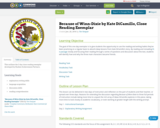
This outlines the 2-day close reading exemplar developed by Student Achievement Partners.
- Subject:
- Arts and Humanities
- Material Type:
- Lesson Plan
- Date Added:
- 11/11/2012

This outlines the 2-day close reading exemplar developed by Student Achievement Partners.
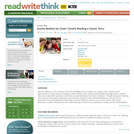
Through a close reading of "Amelia Bedelia", students reread the material to discuss text-dependent questions, promoting deep thinking about the text and its characters.

The attached close reading activities go with the novel The Call of the Wild by Jack London and are aligned to 9-12 CC ELA standards and focus on analyzing word choices, interpreting literary techniques, and determining themes. Full Text: https://www.gutenberg.org/files/215/215-h/215-h.htm Audio Link: https://www.youtube.com/playlist?list=PLVuRdoIItQC9ER0sqT4CTUV1uu7pi1JDK
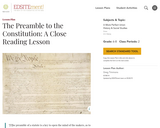
The Preamble is the introduction to the United States Constitution, and it serves two central purposes. First, it states the source from which the Constitution derives its authority: the sovereign people of the United States. Second, it sets forth the ends that the Constitution and the government that it establishes are meant to serve.

What if students could see the relevance of their school curriculum to real-world, interesting, STEM-related careers? Let's help them create a great future!
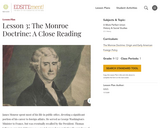
To what events in United States and European foreign affairs does the Monroe Doctrine refer? What was the primary purpose behind the Monroe Doctrine?
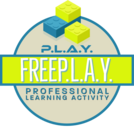
As teachers, one of our primary responsibilities is to help students understand and analyze various types of texts. To do this effectively, we need to have a solid understanding of the text ourselves. This learning activity will help you develop your skills in analyzing texts and prepare you to help your students do the same.
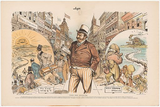
In this lesson, students will begin to work in groups to read their document closely, discovering what the main message is.

How do you read a poem? Intuition is not the only answer. In this class, we will investigate some of the formal tools poets use—meter, sound, syntax, word-choice, and other properties of language—as well as exploring a range of approaches to reading poetry, from the old (memorization and reading out loud) to the new (digitally enabled visualization and annotation). We will use readings available online via the generosity of the Poetry Foundation and the Academy of American Poets. We will also think collectively about how to approach difficult poems.

In this lesson, students will begin by reviewing the play so far and then meet again in groups to read act 4. They’ll do a close reading of Prospero’s lines and take on the perspectives of different characters to comment on his meaning. For homework, students will continue planning their essays.
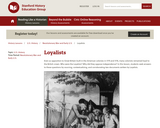
In this brief lesson, students study the writings of Loyalists during the American Revolution in an effort to answer the central historical question: Why did some colonists support England and oppose independence? After a brief teacher introduction establishing historical context, students will read read 2 primary source documents: 1) a pamphlet by Charles Inglis, Anglican minister, explaining the many drawbacks to American independence, and 2) an anonymous newspaper letter urging reconciliation with Britain. While reading, students complete a graphic organizer that applies sourcing, contextualization, corroboration, and close reading to each passage. A final class discussion asks students to draw a conclusion as to whether the Loyalists or Patriots were more reasonable.
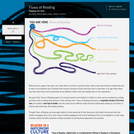
While common usage of the word, text, often refers to written or printed matter, literary and cultural theory extends the term to refer to any coherent set of symbols that transmit meaning to those who know how to read them. In an age where ideas may take many forms and be expressed across different media, texts and reading take on new implications.One goal of the Flows of Reading project is to inspire teachers and students to reflect on what can be considered as reading and what kinds of reading they perform in their everyday lives. Flows of Reading introduces an expanded concept of the term, text, and models a new type of readerĺäĄŕone who reads across different media and who understands reading as an activity of sharing, deconstructing, and making meaning.We have created a rich environment designed to encourage close critical engagement not only with Moby-Dick but a range of other texts, including the childrenĺäĄ_s picture book, Flotsam; Harry Potter; Hunger Games; and Lord of the Rings. We want to demonstrate that the bookĺäĄ_s approach can be applied to many different kinds of texts and may revitalize how we teach a diversity of forms of human expression.
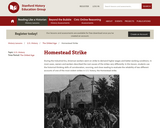
In this lesson, students analyze primary source documents in an effort to answer the central historical question: Why did the Homestead Strike turn violent? The teacher first recaps labor/industry relations of the era and introduces the Homestead Strike with a timeline. The teacher then models sourcing and close reading techniques with a document: Emma GoldmanŰŞs 1931 autobiography. Students then do the same with an 1892 newspaper interview of Henry Frick, followed by corroboration guiding questions that pit the 2 authors against each other. In a final class discussion, students evaluate the validity of the sources and debate whether the historical “truth” about the strike is knowable.
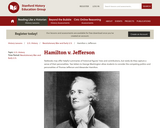
In this lesson, students analyze two primary source documents in an effort to answer the central historical question: What were the differences between [Alexander] Hamilton and [Thomas] Jefferson? Students first read a textbook summary/description (not included) of the Hamilton/Jefferson dynamic. Then, students are given a letter by each manŰÓboth addressed to George Washington and written on the same dayŰÓeach of which addresses the ongoing feud with the other man. In pairs, students read the documents and answer sourcing, corroboration, contextualization, and close reading questions, including some intriguing ones which encourage students to “pick sides” in the rivalry.
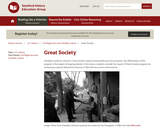
In this lesson, students analyze primary and secondary source documents in an effort to answer the central historical question: Was the Great Society successful? Students first read LBJŰŞs “Great Society” speech and answer sourcing, close reading and context questions about it before discussing as a class. The teacher then hands out a list of Great Society programs and asks: Which have you heard of? Which do you think were successful? Students then watch a film clip about the Great Society, streamed via Discovery Education. This is followed up with 2 secondary sources: a “Pro” perspective from historian Joseph Califano and a “Con” perspective from Thomas Sowell. They fill out a graphic organizer in groups and discuss: Which historian is more convincing? What kind of evidence does each use to make his case? How do these arguments still play out today?
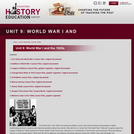
In this lesson, designed to follow a more general lesson on the causes and warring parties of WWI, students analyze primary source documents in an effort to answer the central historical question: Why did the U.S. enter World War I? The teacher begins with a mini-lesson on Woodrow Wilson. Students then read 2 Wilson documents: 1) a 1914 speech urging American neutrality and 2) WilsonŰŞs 1917 speech on the U.S. entry into the war. Students then read their class textbookŰŞs explanation for the end of U.S. neutrality, followed by an excerpt from Howard ZinnŰŞs PeopleŰŞs History of the United States. For all documents, students answer guiding questions which stress contextualization and close reading. A final class discussion evaluates ZinnŰŞs views and compares them to the other sources.

In this lesson, students analyze a primary source in an effort to answer the central historical question: How did Americans react to ShaysŰŞ Rebellion? Students read a textbook excerpt (included) about ShaysŰŞ Rebellion and a letter from Thomas Jefferson speaking about ShaysŰŞ rebels. Students answer questions that ask them to analyze the letter through sourcing, contextualization, close reading, and corroboration questions. A final class discussion corroborates the textbook passage and the Jefferson letter in an effort to challenge the popular account in which all Americans feared the rebellion.
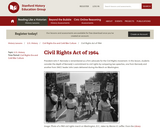
In this lesson, students analyze primary source documents in an effort to answer the central historical question: Was JFK a strong supporter of Civil Rights? First, the teacher streams a video clip from Discovery Education on JFK and civil rights. Students form a hypothesis and discuss whether JFK was ‘strongŰŞ on civil rights based on this. Students then read a 1963 JFK speech supporting the Civil Rights Act; as a class, they answer sourcing, close reading and context questions and revisit their hypothesis. Students then read John LewisŰŞs controversial original draft of the speech he delivered at the March on Washington. They answer guiding questions which corroborate both documents and attempt to reach a conclusion. If there is time, the teacher may bookend the lesson with another clip which shows how LBJ signed the eventual law into action.
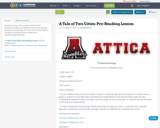
Students will use close reading skills to locate information within a nonfiction text
Students will gain background knowledge of A Tale of Two Cities
Students will apply vocabulary terms towards their understanding of the text
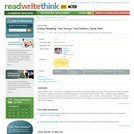
Students make predictions about the stories and analyze story elements, compare and contrast the different stories, distinguish between fact and opinion, and draw conclusions supported by evidence from their readings.